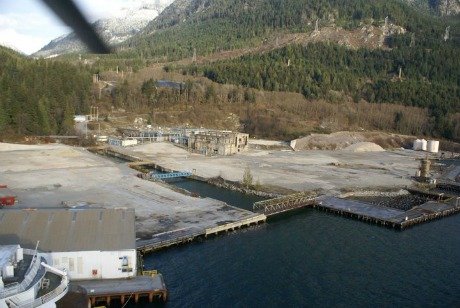By Gagandeep Ghuman
Published: April 5, 2014
With an eye on GHE emissions and airshed quality, Woodfibre LNG proponents say they will prefer electricity over natural gas to run the LNG plant.
“For emissions, the difference between gas and electricity would be significant.” Byng Giraud
In an interview with the Reporter, Byng Giraud, the vice-president of corporate affairs at Woodfibre LNG said they are leaning towards using electricity for the plant, provided the logistics work.
He stressed, however, that no decision has been made. [manual_related_posts]
“There are no guarantees if this is going to happen,” he said.
“We are speaking to BC Hydro, we are talking to our engineers and we are doing our best for what the community desires.”
Giraud said Woodfibre LNG appreciates the community’s concerns regarding GHE emissions and has always preferred electricity to run the operations.
“For emissions, the difference between gas and electricity would be significant,” he said.
He said the project is at preliminary stage and there is much to understand, even for the proponents.
“We will be in a better position to talk about it when we have a critical understanding of the facts on the ground a few months from now,” he said.
Not oblivious to the wave of criticisms about LNG proposal, Giraud said he would urge people to not jump to conclusions.
He picked up the discussion on taxes in the social media and in some other media as an example.
“How can we be accused of not paying enough taxes when we haven’t even been told what to pay?”
Giraud said it’s unrealistic to imagine that a project with $1.7 billion capital expenditure would be a small tax payer.
“I don’t know who the biggest tax payer in Squamish is right now, but we are going to be bigger than that,” he said.
Giraud said taxes are a legitimate concern, and there are three government agencies working on the number.
“I will pay whatever the government asks me to pay, but I just can’t put a number on it right now, that’s all,” he said.
On concerns that there would be highly specialised jobs that will only go to foreign workers, Giraud said that is far from the truth.
“There is more talent in Squamish than people are willing to give it credit for,” he said.
He said in the next few months, he would have a better sense of what kind of people they are looking for.
“We will know how many welders, pipe fitters, power engineers and other trades people we will need for this,” he said.
The company would also hold a job fair in town at some point, he added.
Giraud said the company has heard from the community and is intently listening to both praise and criticism.
He said Woodfibre LNG will come back to the community to hold more public consultation meetings in the future.





Jean says
Let Mr.Giraud make the firm statement that only electricity is what W-LNG would consider. this preferably under oat.
Let the Government ,definitely under oat, make a declaration that W-LNG will not be subsidized by the Government ( People of BC)
If LNG floating Plant is build in a ship yard in Asia or Texas, only few Jobs are required here.
Eoin Finn says
Good that Woodfibre LNG (W-LNG) is leaning toward using Hydro power. Burning gas for power would be simply unacceptable.
But… there are still several other business-case unknowns, including:
– Property Taxes: The Provincial Government has given itself the power to cap local taxes on energy projects. It is not improbable that Squamish could end up with much-reduced tax revenue from the site.
– Construction Jobs: W-LNG favours a floating liquefaction plant over a land-based one. If so, this will be built overseas and the “$1.7 Billion capital investment” won’t be made here. There likely won’t be “approximately 600” short-term construction jobs, and the Province won’t collect any GST/PST or other taxes on construction materials and services.
– Permanent Jobs: Experience from comparable LNG export plants in Australia indicate that the “100 permanent” jobs at the plant may be an over-estimate
– Income & LNG Royalty Taxes: As described to the National Energy Board, there are two Woodfibre LNG companies. The first, Woodfibre Natural Gas Ltd., is Canadian-registered and will operate the plant, if built. The other, Singapore-registered Woodfibre LNG Export Pte. Ltd., is the one granted the LNG export license from NEB. It will likely buy the gas, own the assets, and contract (via a “tolling agreement”) with Woodfibre Natural Gas to liquefy and store it, and then sell the LNG in Asia. In that case, profits would likely be taxed by Singapore, not Canada. And the return to BC’s coffers from proposed LNG royalty taxes, which are based on net profit, would greatly depend on the terms of the contract between these two privately-owned, related companies.
– Gas supply: The rate BC Utilities Corp. will set for W-LNG for Fortis-supplied gas and, more importantly, how that will affect local supplies and rates.
– Liability Insurance: If, as described above, the plant is foreign-owned, and the visiting tankers are also, settlement of liabilities for a major accident at the plant or the tankers may be difficult, if not impossible, to pursue.
Answers to these and other business issues and concerns have yet to be determined. The quicker they become known, the better residents of the Sound can evaluate whether or not we want this project.
Jean says
EION thanks great stuff,
Her is the story http://business.financialpost.com/2014/04/07/blast-at-u-s-lng-site-casts-spotlight-on-natural-gas-safety/?__lsa=f18b-f878e it is a bedtime story for those that can take it without getting nightmares.
TJay says
And away from the populace, can’t get safer than that 11